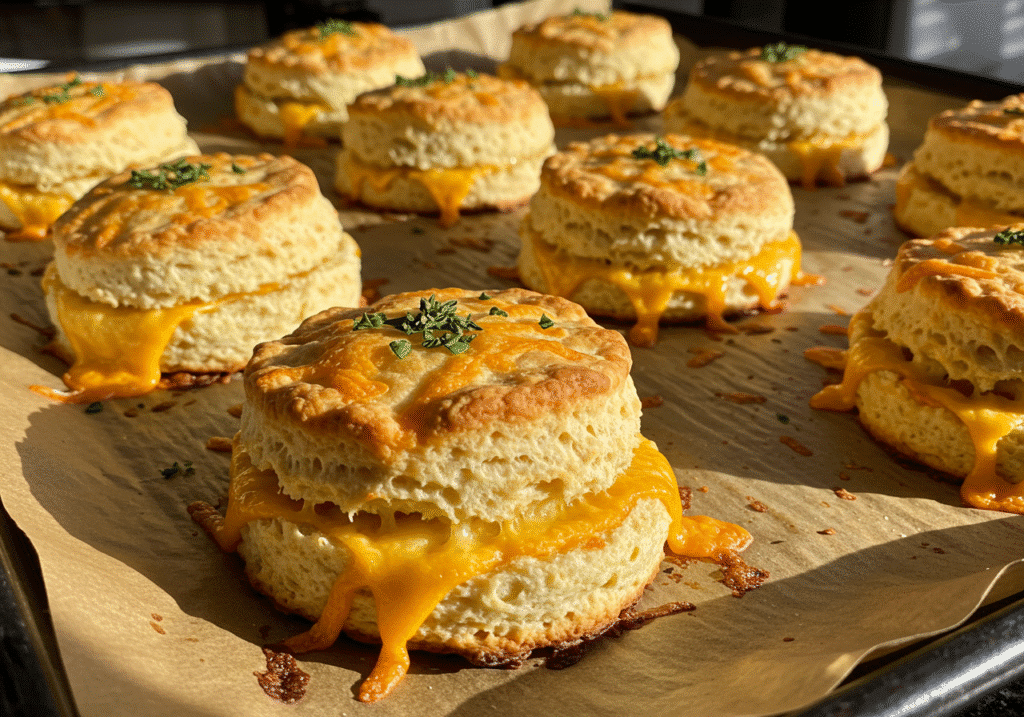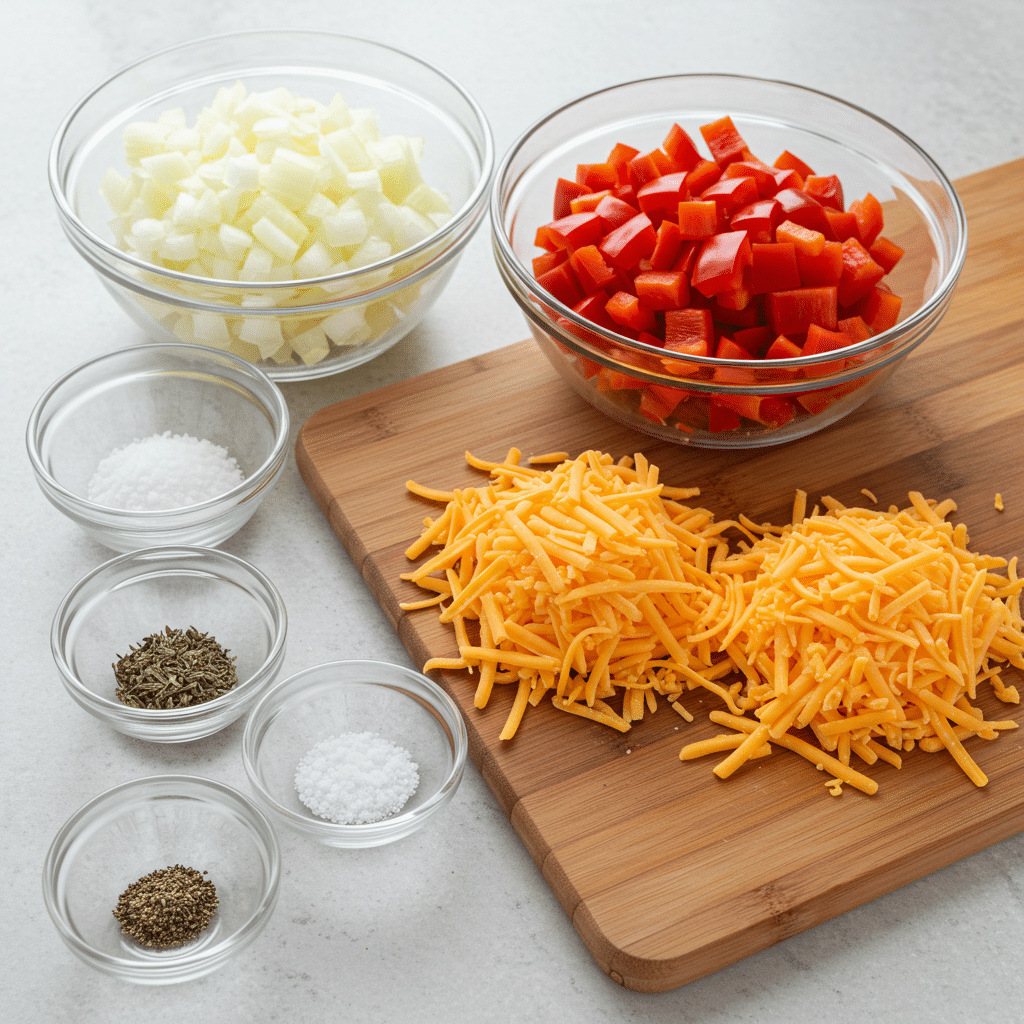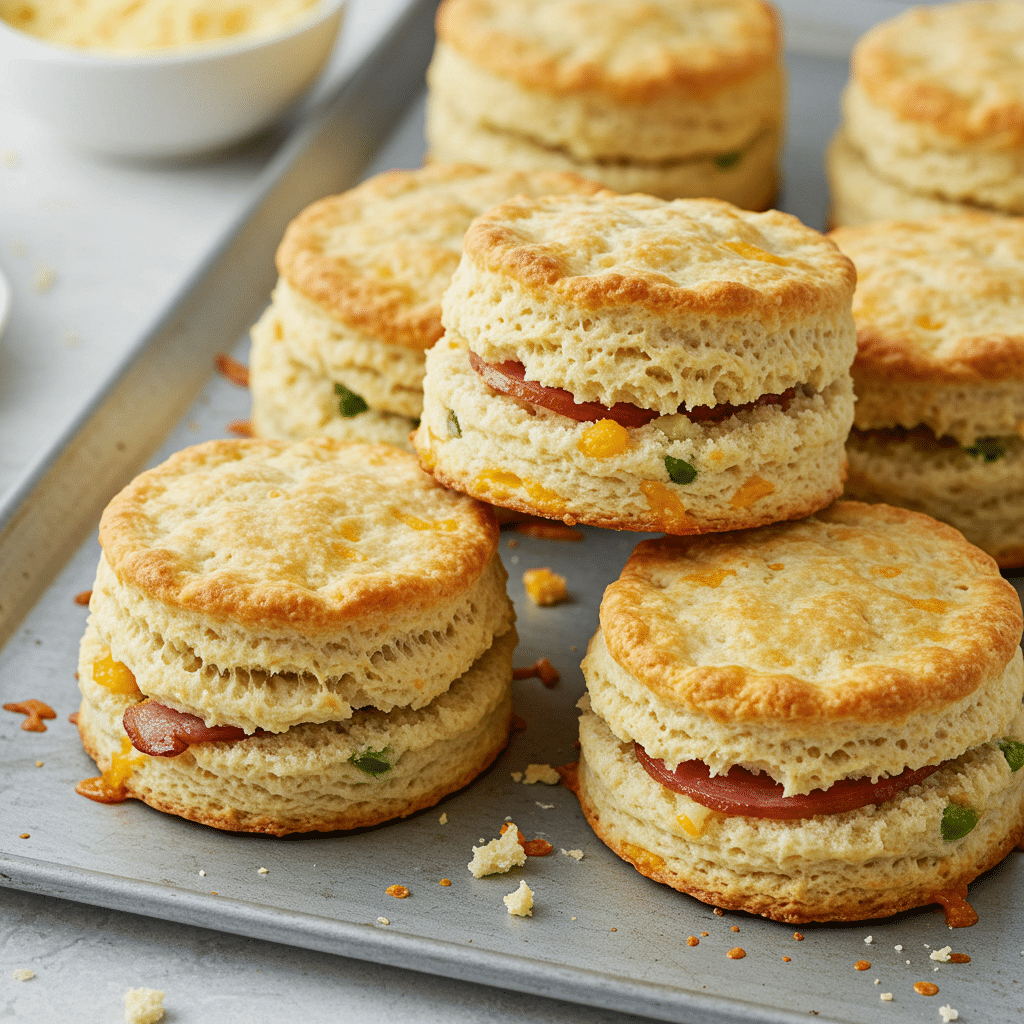On a crisp morning nothing compares to the warm, savory scent of breakfast biscuits filling your kitchen. Breakfast biscuits are the ideal balance of comfort and convenience whether you’re enjoying a leisurely weekend brunch or hurrying out the door. Along with a delicious high-protein breakfast biscuit recipe this guide offers storage tips, nutrition information and an intriguing backstory of this Southern classic.

Table of Contents
Breakfast Biscuits
Breakfast Biscuits
What Are Breakfast Biscuits?
Breakfast biscuits are fluffy savory baked goods typically made from flour, eggs, baking powder and a variety of flavorful ingredients like sausage, cheese and herbs. Unlike their plain counterparts these biscuits serve as a complete breakfast-in-one loaded with protein and satisfying textures. Popular in the American South they’re both hearty and incredibly customizable perfect for feeding families or freezing for meal prep.
The breakfast biscuit is more than a biscuit it’s a portable breakfast sandwich without the hassle of layering, wrapping or rushing Just grab and go.
Why Breakfast Biscuits Are a Morning Favorite
There are plenty of reasons breakfast biscuits have stood the test of time. They’re:
- Quick to make with minimal prep
- Perfectly portable making them great for on-the-go mornings
- Endlessly versatile from cheesy to spicy to veggie-packed
- Freezer-friendly saving time during busy weekdays
- Kid-approved offering a fun twist on boring breakfasts
In today’s fast-paced world more people are swapping sugary cereals and bland toast for something more wholesome, filling and flavorful. Breakfast biscuits answer that call balancing rich taste with hearty nutrition.
Ingredients Breakdown for the Best Breakfast Biscuits
Key Proteins and Their Roles: Why Chicken Sausage Works Best
For a wholesome high-protein biscuit without the heaviness of pork, ground chicken sausage is an excellent choice. It offers a leaner, lighter texture that blends beautifully with cheese and herbs without overpowering the other flavors. Chicken sausage contains just the right amount of fat to keep your biscuits moist, without making them greasy.
Benefits of using chicken sausage:
- Lower in saturated fat compared to pork
- Milder flavor, which pairs well with bold seasonings
- Cooks faster, reducing overall prep time
- Kid-friendly and great for those avoiding red meat
If you’re using pre-seasoned chicken sausage you might want to reduce added salt or herbs in the mix. However, unseasoned sausage allows you full control over flavor.
Flavor Enhancers: Herbs, Cheese and Veggies
The flavor foundation of breakfast biscuits lies in a simple combination of fresh veggies, savory cheese and aromatic herbs. Here’s how each element contributes:
| Ingredient | Purpose |
|---|---|
| Yellow onion (½ cup) | Adds sweetness and depth after sautéing |
| Red bell pepper (1 cup) | Provides color, crunch and natural sweetness |
| Shredded cheddar (1 cup) | Melts into the dough, adding richness and flavor |
| Dried sage (½ tsp) | Earthy, warm flavor that complements chicken perfectly |
| Dried thyme (¼ tsp) | Brings a touch of freshness and light herbal notes |
| Salt & pepper | Enhances all flavors and balances the mix |

These components make the biscuit hearty, colorful and satisfying in every bite. Want it spicier? Add jalapeños or smoked paprika. Prefer more creaminess? Mix in a touch of sour cream or cream cheese with the eggs.
Choosing the Right Flour and Leavening Agent
At the heart of every fluffy biscuit is the perfect balance of flour and baking powder. Here’s how to get it right:
- All-purpose flour (2 cups): This is ideal for giving structure without making the biscuits too dense. For gluten-free options, a 1:1 gluten-free flour blend works well with slight texture differences.
- Baking powder (2 tsp): This gives your biscuits their rise and fluffiness. Be sure your baking powder is fresh expired leavening results in flat biscuits.
- Salt (1 tsp): Enhances flavor and helps balance the cheese and sausage.
- Freshly ground black pepper (½ tsp): Adds just enough bite to cut through the richness of cheese and eggs.
These base ingredients create the signature flaky golden crust and tender interior breakfast biscuits are known for.
Step-by-Step Breakfast Biscuits Recipe
Prepping the Oven and Tools
Before you start cooking preparation is key. A well-prepped workspace ensures you move through each step smoothly and avoid soggy or overcooked biscuits.
Here’s what you’ll need:
- Oven preheated to 400°F (200°C)
- A large 18×13-inch baking sheet lined with parchment paper
- Large mixing bowls (2)
- A skillet (nonstick or cast iron preferred)
- Measuring cups and spoons
- A rubber spatula or wooden spoon
- A meat chopper or spatula to break up sausage
- Ice cream scoop or large spoon for portioning
Tip: Always preheat your oven first. Biscuits need a hot environment to rise fast and bake evenly.
Cooking Veggies and Browning the Chicken Sausage
Start with the flavor base onions and bell peppers. Sautéing them first ensures they’re soft, aromatic and won’t release excess moisture into the dough.
- Heat 1 tablespoon olive oil in a large skillet over medium heat.
- Add diced onion and red bell pepper. Sauté for 5 minutes, stirring occasionally until softened.
- Push the veggies to one side of the pan.
- Add 16 oz ground chicken sausage to the other side. Use a meat chopper or spatula to break it into small crumbles.
- Cook until browned and cooked through about 6–8 minutes.
- Mix the sausage and veggies together in the pan then remove from heat and let it cool slightly.
This mixture becomes the savory soul of your biscuits. Be sure not to skip the browning it builds flavor that carries through every bite.
Combining Wet and Dry Ingredients Like a Pro
Now that your filling is ready it’s time to make the dough. This step brings everything together into a biscuit batter that’s moist, flavorful, and scoopable.
- In a large bowl whisk together:
- 2 cups all-purpose flour
- 2 teaspoons baking powder
- 1 teaspoon salt
- ½ teaspoon black pepper
- ½ teaspoon dried sage
- ¼ teaspoon dried thyme
- In a second bowl beat 6 large eggs. Then stir in:
- 1 cup shredded cheddar cheese
- The cooked sausage and veggie mixture
- Make a well in the dry flour mix and pour in the wet egg mixture.
- Gently stir until fully combined. The dough will be wet, thick and slightly sloppy this is normal!
Avoid overmixing which can make biscuits tough. Just fold until all ingredients are evenly distributed.
Baking Tips for Golden, Fluffy Biscuits
Now it’s time to transform the mixture into delicious ready to eat biscuits.
- Scoop 12 equal portions (about ⅓ cup each) onto the prepared baking sheet. Leave space between each one.
- Bake for 10 to 14 minutes or until the tops are golden and the biscuits are firm to the touch.
- For extra browning, brush with a little melted butter at the 10-minute mark and return to oven for 2–4 more minutes.
- Remove and let them cool on the baking sheet for 5 minutes before serving.
You now have a dozen hot, hearty breakfast biscuits ready to enjoy!
Breakfast Biscuit Variations and Flavor Twists
Spicy, Cheesy or Veggie? Creative Mix-ins to Try
One of the best things about breakfast biscuits is their versatility. With a few ingredient swaps or additions you can create multiple flavor profiles from one basic recipe. Here are some popular and delicious variations:
1. Spicy Kick Biscuit
If you’re into bold flavors try these tweaks:
- Add ½ teaspoon crushed red pepper flakes to the dry ingredients
- Use pepper jack cheese instead of cheddar
- Mix in diced jalapeños or green chilies with the veggies
These spicy biscuits are perfect for those who like heat with their morning brew.
2. Cheesy Overload Biscuit
Want that gooey melty texture?
- Double the cheese (1 cup cheddar + ½ cup mozzarella or Colby Jack)
- Add a sprinkle of parmesan on top before baking
Pro tip: Fold cheese cubes directly into the dough for cheesy pockets in every bite.
3. Veggie-Packed Breakfast Biscuit
For a lighter meat free version:
- Skip the sausage entirely or use plant-based sausage crumbles
- Add a mix of cooked mushrooms, spinach and zucchini (drain moisture first)
This version caters to vegetarians or anyone looking for a break from meat.
4. Mediterranean Style
A delicious twist inspired by Mediterranean ingredients:
- Replace cheddar with crumbled feta
- Add chopped sun-dried tomatoes and a few olives
- Sprinkle with oregano and basil
These are especially great for brunch spreads or savory snacking.
Gluten-Free and Dairy-Free Breakfast Biscuit Options
Whether you have dietary restrictions or just want a cleaner version, breakfast biscuits can be easily adjusted:
Gluten-Free Option
- Replace the all-purpose flour with a 1:1 gluten-free baking mix (with xanthan gum for structure)
- Use aluminum-free baking powder to avoid any bitterness
Gluten-free biscuits may be slightly more tender but just as delicious.
Dairy-Free Option
- Swap the cheddar cheese for dairy-free shredded cheese (like almond or coconut-based)
- Use plant-based butter or oil instead of traditional dairy in add-ons
- Skip cheese entirely and double the veggies for a clean, flavorful version
Common Mistakes to Avoid with Breakfast Biscuits
Overmixing and Undercooking: Biscuit-Busting Errors

Even the best ingredients can’t save a batch if the method goes wrong. Whether you’re a first-timer or seasoned home cook, here are the most frequent mistakes to steer clear of when baking breakfast biscuits:
1. Overmixing the Dough
When combining your wet and dry ingredients, it’s tempting to mix until perfectly smooth but don’t. Overmixing leads to:
- Tough, dense biscuits with a rubbery texture
- Loss of those soft, fluffy layers you’re aiming for
Tip: Mix only until the dough comes together. It should still be slightly lumpy and moist.
2. Underbaking the Center
Pulling biscuits out of the oven too early is a common mistake:
- The outside may appear golden but the inside stays doughy
- If using moist mix-ins like veggies or cheese, underbaking becomes even more likely
Fix: Always bake until the tops are golden and the biscuits spring back when gently pressed. You can also use a toothpick test to check the center.
3. Not Preheating the Oven
Biscuits need a hot oven to rise properly. Skipping the preheat or using an uneven temperature can cause:
- Flat or gummy biscuits
- Uneven browning or burnt bottoms
Solution: Always preheat to 400°F (200°C) and allow your baking sheet to warm slightly with the oven for better base texture.
Ingredient Substitutions That Don’t Work
Trying to make your biscuits healthier or fit what’s already in your pantry can backfire if not done correctly. Here are swaps to avoid:
1. Swapping Olive Oil for Butter in Baking
While olive oil works well for sautéing it can:
- Change the flavor profile dramatically when used in dough
- Prevent proper rise if added directly into the mix
Best Practice: Stick with olive oil only for cooking sausage and veggies, not for replacing baking fats.
2. Using Low-Fat Cheese
It may seem like a good choice but low-fat or pre-shredded cheese can:
- Melt poorly or clump up in the dough
- Lack the richness needed for flavor balance
Use full-fat cheddar or high-quality cheese for the best result.
3. Skipping Baking Powder
Never rely on self-rising flour without checking your ratios. Without the right amount of baking powder your biscuits will:
- Turn out flat and dense
- Miss the airy, fluffy texture you expect
Always measure 2 full teaspoons of baking powder for every 2 cups of flour in this recipe.
History and Origin of Breakfast Biscuits
The Southern Roots of Biscuits in Breakfast Culture
The comforting flakiness of breakfast biscuits is more than a culinary pleasure it’s a bite into American Southern history. Biscuits began as a practical food during colonial times. Early settlers, especially in the South, needed quick, hearty staples that could be made from simple ingredients like flour fat and salt.
By the 19th century biscuits evolved from hard unsweetened bread rolls into the soft, layered baked goods we know today. But it wasn’t until the early 20th century that biscuits took on their now-iconic breakfast identity particularly in Southern households where meat, gravy and eggs were commonly added.
Key historical influences:
- Southern hospitality culture, where big breakfasts were the norm
- Availability of baking powder and cast-iron stoves, which made home-baking faster
- The rise of breakfast sausage, adding protein and substance to morning meals
In the South pairing biscuits with gravy or sausage became a tradition that traveled nationwide. Over time, innovations like chicken sausage and plant-based fillings gave the classic dish a modern twist.
When and Where Breakfast Biscuits First Appeared
While biscuits themselves have deep roots breakfast biscuits as we know them packed with eggs, meat and cheese are relatively modern.
Fast food’s role in popularizing breakfast biscuits:
In the early 1980s major fast-food chains like Hardee’s and McDonald’s introduced breakfast sandwiches featuring biscuit buns. These handheld meals quickly became popular due to their:
- Convenience
- Hearty ingredients
- Comfort-food appeal
This fast-food influence brought breakfast biscuits into the mainstream, especially across the United States, where they remain a staple in diners, drive-thrus, and homes.
Today the homemade version is preferred by many who want to control their ingredients and make healthier choices, like using chicken sausage, gluten-free flours, or dairy alternatives.
Nutritional Value and Health Tips
Calories, Protein, Carbs and More
While breakfast biscuits are known for being hearty and satisfying it’s important to understand their nutritional profile especially for readers focused on balanced eating. Using chicken sausage instead of pork helps keep these biscuits leaner while still delivering protein and flavor.
Here’s a general estimate for one biscuit (based on the 12-serving batch and standard ingredients used in this recipe):
| Nutrient | Amount per Biscuit (approx.) |
|---|---|
| Calories | 210–230 kcal |
| Protein | 12–14 g |
| Carbohydrates | 15–18 g |
| Total Fat | 10–12 g |
| Saturated Fat | 3–4 g |
| Fiber | 1 g |
| Sodium | 400–450 mg |
Note: Values can vary depending on the brand of cheese, sausage or flour used. For lighter biscuits you can reduce the cheese or use egg whites instead of whole eggs.
Making Healthier Breakfast Biscuits Without Sacrificing Taste
If you’re trying to eat clean or reduce calories, there are simple swaps and tips you can apply without compromising on flavor:
1. Use Lean Chicken Sausage or Plant-Based Alternatives
Chicken sausage already cuts down on saturated fat. For vegetarians or vegans you can use:
- Soy-based sausage crumbles
- Chopped mushrooms with smoked paprika for a meaty flavor
2. Choose a Whole Wheat or Gluten-Free Flour Blend
Whole wheat flour adds fiber and nutrients. Just be aware it creates a denser biscuit, so mix it 50/50 with all-purpose flour if needed.
Gluten-free baking mix also works but requires attention to moisture levels.
3. Reduce Cheese or Use Nutritional Yeast
Cut the cheese amount in half or replace it with:
- Dairy-free cheese alternatives
- Nutritional yeast, which gives a cheesy taste without fat or lactose
4. Limit Sodium
Skip added salt if your sausage or cheese is already salty. You can also:
- Use low-sodium cheese
- Season with garlic powder, black pepper, or herbs instead
5. Boost the Veggies
Add volume and nutrients by including more sautéed or steamed vegetables:
- Spinach, kale, mushrooms, or zucchini work great
- Make sure they’re cooked and drained to avoid a soggy dough
These changes allow you to tailor your healthy breakfast biscuit recipe to suit various dietary goals, whether it’s low-carb, low-fat or high-protein.
How to Store and Freeze Breakfast Biscuits
Keeping Biscuits Fresh for Days
Whether you’ve made a big batch for the family or are saving extras for the week, proper storage ensures your breakfast biscuits stay fresh, moist, and flavorful.
How to Store Biscuits in the Refrigerator
- Let the biscuits cool completely on a wire rack after baking.
- Place them in an airtight container or zip-top bag with parchment paper between layers.
- Store in the fridge for up to 4 days.
Refrigerated biscuits are great for grab-and-go breakfasts during the workweek. They’ll maintain texture and flavor when reheated properly.
Reheating Tips:
- Microwave: Wrap one biscuit in a paper towel and heat for 30–45 seconds.
- Oven or toaster oven: Reheat at 350°F (175°C) for 5–7 minutes for a crispier finish.
- Air fryer: Heat at 320°F for 4 minutes for a quick re-crisp.
Best Practices for Freezing and Reheating
Breakfast biscuits freeze surprisingly well, which makes them a smart option for busy households or weekly meal planners.
How to Freeze Biscuits (Step-by-Step):
- Cool biscuits completely to room temperature.
- Wrap each biscuit individually in plastic wrap or foil.
- Place wrapped biscuits into a freezer-safe zip bag or airtight container.
- Label with the date and freeze for up to 3 months.
This prevents freezer burn and keeps flavors locked in. You can freeze the entire batch or just leftovers.
How to Reheat Frozen Biscuits:
- Microwave (Quickest): Unwrap, place on a plate, and heat for 60–90 seconds at 70% power.
- Oven (Best for texture): Preheat to 350°F and bake frozen biscuits on a tray for 12–15 minutes.
- No Thaw Needed: Frozen biscuits can go straight from freezer to oven or microwave just adjust cooking time slightly.
Freezer Tip: Flash-freeze unbaked biscuit dough portions and bake fresh as needed! Simply scoop onto a tray, freeze for 1 hour then transfer to a freezer bag.
Storing and freezing breakfast biscuits is a game-changer for anyone juggling busy mornings. With just a little prep you can enjoy hot, homemade biscuits in minutes any day of the week.
Serving Ideas and What Goes Best with Breakfast Biscuits
Pairing Breakfast Biscuits with Drinks and Sides
A batch of warm cheesy breakfast biscuits can absolutely stand on their own but pairing them with the right sides and beverages turns a quick bite into a complete, satisfying meal.
Top Drink Pairings:
- Freshly brewed coffee or espresso: Classic, rich and warming
- Cold brew or iced coffee: Great with spicy or cheesy biscuit variations
- Fresh orange or apple juice: Balances savory flavors with a refreshing zing
- Herbal tea (chamomile or mint): Pairs nicely with lighter, veggie-packed biscuits
- Protein smoothies: For a high-protein, energizing combo
Easy Side Dishes to Serve with Breakfast Biscuits:
- Fresh fruit salad or sliced avocado for balance
- Yogurt parfaits for a creamy, tangy side
- Roasted breakfast potatoes or hash browns
- Scrambled or poached eggs if you didn’t include eggs in the biscuits
- Light salad with lemon vinaigrette for a brunch-style spread
These combinations add freshness, texture and nutrition to your meal whether you’re hosting brunch or eating solo on a weekday morning.
Turning Biscuits into Full Breakfast Sandwiches
You can also repurpose your breakfast biscuits into hearty, handheld sandwiches perfect for packed lunches or high-protein breakfasts.
Creative Breakfast Biscuit Sandwich Ideas:
- The Classic
Slice biscuit add a fried egg and a slice of tomato or avocado. Optional( dash of hot sauce) - The Protein Boost
Add a grilled chicken breast or turkey bacon with greens and a slice of cheese. - Veggie Sunrise
Layer in sautéed spinach, roasted red peppers and dairy-free cheese for a meatless option. - Spicy Stack
Fill with jalapeños, scrambled eggs and chipotle mayo or pepper jack.
To assemble reheat the biscuit, slice it horizontally and layer your fillings. Wrap in parchment if prepping for lunch or travel.
Conclusion
Whether you’re looking to simplify your mornings, batch prep for the week or simply enjoy a hearty homemade meal breakfast biscuits are your all-in-one solution. From their humble Southern roots to freezer-friendly convenience, these fluffy savory bakes offer a blend of tradition and modern health-conscious twists.
With customizable ingredients quick prep and endless variations this recipe proves that breakfast doesn’t have to be boring or time-consuming. So roll up your sleeves, heat that oven and bake up a batch that’s perfect for you.
FAQs About breakfast biscuits
What are some common mistakes to avoid when making breakfast biscuits?
Some of the most common mistakes include:
Overmixing the dough, which leads to tough, dense biscuits
Underbaking, resulting in a raw or doughy center
Skipping the preheat, causing flat or uneven baking
Using low-quality cheese or sausage, which affects both flavor and texture
Neglecting to cool properly, which traps steam and makes biscuits soggy
Avoid these missteps to ensure fluffy, flavorful biscuits every time.
Where did breakfast biscuits originate?
Breakfast biscuits originated in the Southern United States where traditional biscuit-making was already a staple of home cooking. Over time, they evolved into a full meal when filled with ingredients like sausage, eggs and cheese initially in homes and later popularized nationwide by fast food chains like McDonald’s and Hardee’s in the 1980s.
When were breakfast biscuits invented?
While biscuits have existed for centuries, the modern breakfast biscuit a biscuit filled with protein, cheese and sometimes gravy emerged in the early to mid-20th century, becoming especially widespread in the 1980s thanks to fast food breakfast menus. The idea of combining biscuits with breakfast ingredients quickly became an American morning favorite.
What are the nutritional facts of breakfast biscuits?
A single serving of homemade breakfast biscuit made with chicken sausage typically contains:
210–230 calories
12–14 grams of protein
15–18 grams of carbs
10–12 grams of fat
400–450 mg of sodium
Values can vary based on your choice of sausage, cheese and mix-ins. To reduce calories, consider using lower-fat cheese, extra veggies or smaller portions.

Breakfast Biscuits with Chicken Sausage and Cheese
- Total Time: 34 minutes
Ingredients
1 tbsp olive oil
1/2 cup diced yellow onion
1 cup diced red bell pepper
16 oz ground chicken sausage
6 large eggs, beaten
1 cup shredded cheddar cheese
2 cups all-purpose flour
2 tsp baking powder
1 tsp salt
1/2 tsp black pepper
1/2 tsp dried sage
1/4 tsp dried thyme
Instructions
Preheat oven to 400°F (200°C) and line baking sheet with parchment paper.
Sauté onion and bell pepper in olive oil for 5 minutes.
Add chicken sausage, cook until browned.
Whisk flour, salt, pepper, baking powder, and herbs.
In a separate bowl, whisk eggs and mix in cheese and sausage mixture.
Combine wet and dry ingredients. Scoop 12 portions on tray.
Bake for 10-14 minutes until golden.
- Prep Time: 20 minutes
- Cook Time: 14 minutes
- Category: breakfast

